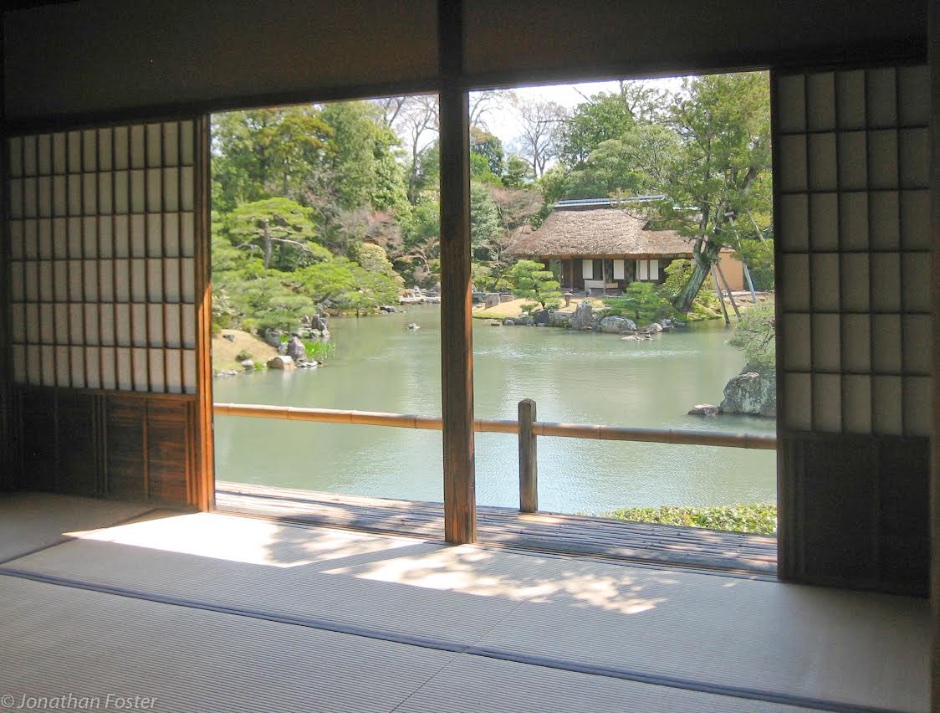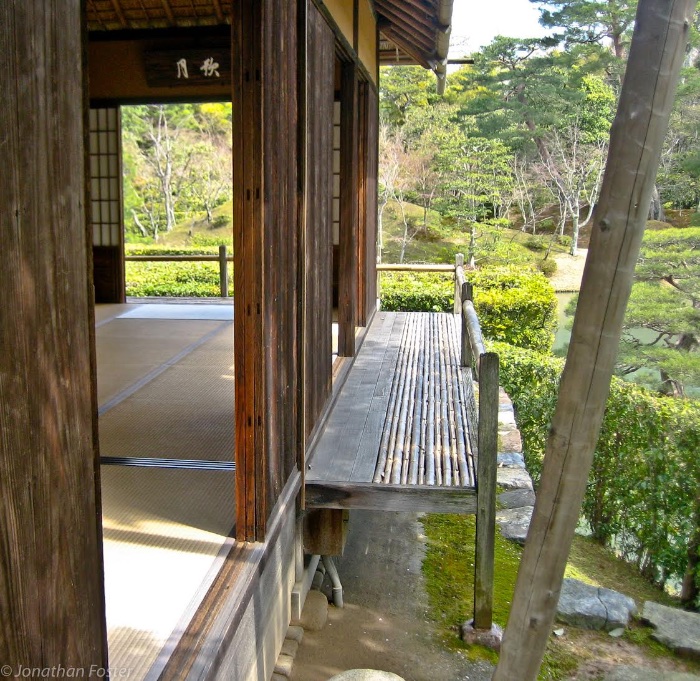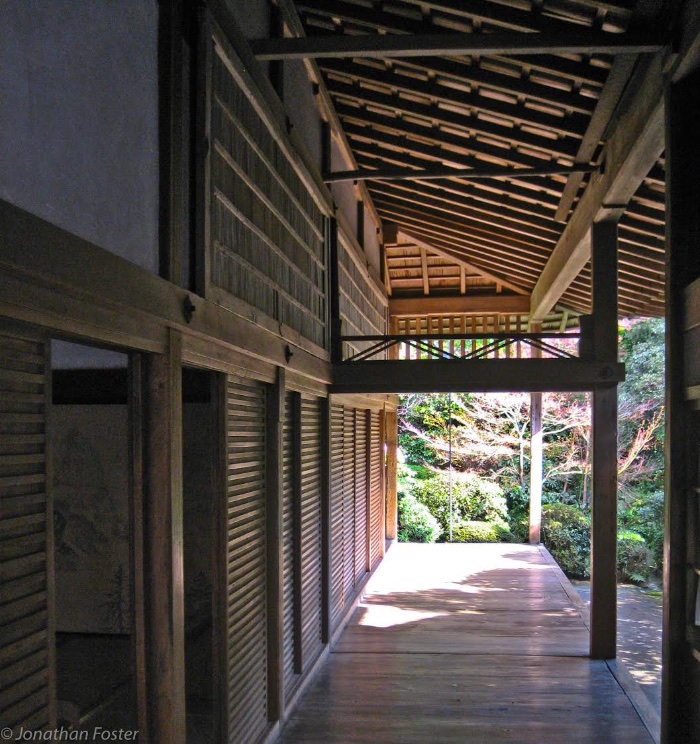A Review of the Tale of Genji with a Focus on Architecture
by Jonathan S. Foster, Architect
A decade ago, I was in Dobbs Ferry designing and building a large mansion addition to a 1928 Devon-Tudor style house that had been the gardener’s cottage to a large estate nearby. While I was busy with that, I also explored the overgrown backyard and discovered hints that it was originally a Japanese garden with a small stream and pond, two dams, and the foundation for a bridge. It required a lot of clearing out to bring it back to life and it inspired me to read the Tale of Genji.
I finished the house and connected with the Japan Society of Boston and began a trip to the land of Zen, tea, ikebana, and wabi-sabi.
This year, I began to re-read Genji to bring back some of that experience, and I began to notice some of the buildings I saw, such as Kiyomizu-dera temple in Kyoto and the Ise shrine near Nara, were mentioned in the story. There was much talk related to the building and architecture, and I saw that architecture played a great part in the narrative because of the palace activities, celebrations, additions to houses for new wives, and so forth. I decided to follow up using a review with an architectural theme. I discovered that the architecture of Genji had taken on a life of its own through the millennia.
The Tale of Genji was written one thousand years ago by a woman for women. Murasaki Shikibu wrote in Hiragana characters, a written language, which was developed by women for women and is now a vital part of written Japanese. Murasaki lived in the Imperial world of 1000 CE Kyoto and learned poetry and Chinese, the language of official Japan, by listening to her provincial governor father while he taught her brother in the next room. Recruited by the Imperial household to help educate and entertain the Empress Akiko and her ladies in waiting, she produced what many consider the first modern novel. Since her clients were an elite group of young teenagers, one could understand it as a guide to how the world works, and one could infer that it implies that how you act in it will affect your life. The Genji Monogatari, the story of Hikaru Genji, The Shining Prince, has many other themes running through it, often highlighted at some point in the story by a detailed description of the issue or practice. Genji concentrates on the everyday way of life, focusing on beauty, proficiency in music, painting, poetry, making and dyeing fabrics, and even psychology and memory. Her writing has been compared with Marcel Proust and Virginia Wolfe because of the way it explores inner conflicts and how the passage of time occurs in the novel. It is much more readable than Proust or Wolfe, however. There are also over 750 Waka poems , (like Haiku),in the novel. The characters in the book communicate with each other in poetry, which brings to light the wit, skill, and calligraphic sensitivity of the individual as well as his or her historical knowledge. In his 2015 The New Yorker review, Ian Burma sums it up as, The main thing required of a noble gentleman in Heian Japan was a sense of style. Seducing another man’s wife could be forgiven; a bad poem, clumsy handwriting, or the wrong perfume could not.
Although the richness in Murasaki’s world can be overwhelming as well as fascinating, it is the architecture of Heian Japan that structures this activity and allows it to develop coherence and meaning. Architecture makes itself known throughout the course of the book. One becomes fully aware of thinking about spatial relationships early on because of the descriptions of the activity. Events take place after dark as Genji prowls through the courtyards of potential conquests, accessing the veranda, finding the correct sliding panels for entry, talking through standing screens, and hearing rustling through the distant shoji. He was at times able to peek beyond, through, or around a screen to see the profile of a desired one. The conversations take place talking behind a standing screen, speaking and writing Waka on paper, or handing notes off to a messenger to transmit to the intended interlocutor. People were not seen, and voices were not always heard. Meaning was transmitted by the messenger with the poem on colored, scented paper. One can see the problems Genji had navigating the building, much less the situation. Men could not see the women, and the women only saw the men while discretely looking through openings in walls.
The Shinden, the basic Heian Palace building type in Genji, was a wooden structure of about 50ft x 70ft, based on a 10-foot column grid. This allowed for an adaptable plan layout, which could be rearranged regularly through the use of movable shoji that were mostly solid panels. There was no ceiling, just the roof far above the beams, which were at “room” height. Ancillary structures were connected to the east and west via bridges, and the south had a large courtyard and ponds for large celebrations. It was on one of those bridges that Genji’s teenage son, Yugiri, first saw Genji’s stunning wife through a storm-damaged hinged panel which revealed the interior and the hidden women inside. That experience profoundly shocked Yugiri and allowed him to see what life was about. It stayed with him forever.
At the time, when he was about 30 years old, Genji received a 14-acre plot on Rokujo (6th Avenue), in downtown Kyoto. He built an expansive mansion of four Shinden, each with accompanying structures, gardens, and ponds to accommodate his various wives and girlfriends.
Genji personalized the different wings of his house for his women using a four-seasons theme in the landscaping of the estate. The spring pavilion, where Genji shared his life with his great love, was planted with wisteria, kerria rose, cherry trees, and other spring plantings. It was at its most magnificent at springtime. Similarly, with the remainder, he directed his gardeners to divert a stream to create ponds for islands and boating and for fishing from the bridges. Mountains were created as necessary, such as for a cedar forest in the winter garden. The Japanese word for gardening, “sakuteiki,” means “the art of setting stones,” and everything else stems from that. Gardeners learned and developed their techniques for hundreds of years before Genji. These techniques were first codified by Tachibana no Toshitsuma in the Sakuteiki, the handbook of Japanese gardening, only 40 years after Murasaki wrote Genji. It is interesting that Toshitsuma’s father was the Imperial Regent who built a palace the size of Genji’s in the Katsura district of Kyoto when Toshitsuma was a teenager. He became fascinated with the planning and execution of the gardens and wrote down all the gardening techniques into a book. It was in this way that the power of Murasaki’s vision of an aesthetic life here manifests itself not only in a weekend palace in the country but also in a powerful guidebook on the techniques of ideal Japanese gardening.
Maybe even more startling is what happened 500 years later. Prince Hachijo Toshihito, who was adopted by the Shogun Hideyoshi, the powerful unifier of Japan in the 1590s, built a palace now known as the Katsura Imperial Villa. Toshihito was close to Hideyoshi and to his tea master Sen no Rikyu. Rikyu brought the simple rustic wabi-sabi influence to the tea ceremony replacing its formalist Chinese influences, making it fully Japanese. Toshihito brought those ideas together with his love of the Genji Monogatari to the creation of his Katsura Villa.
The main structure of the Villa is very much a descendant of the Heian Shinden. There is also a refined teahouse aesthetic, the Sukiya Style of Sen no Rikyu which featured carefully crafted delicate interiors. The garden is composed of the islands and shores created by diverting some of the Katsura River into the estate. Five teahouses are placed along a long winding path through different gardens, and their seasonal variations return to the main Old Shoin and its moon-viewing platform.
The creation of the Katsura Villa represented the integration of the ideas of beauty and the aesthetic life in Murasaki’s novel and the Sukiya of Rikyu represented in the tea ceremony with joyful feeling of the unification of Japan under Hideyoshi. This is the core of Japanese culture made manifest. This would not have been possible without the evocative writing of Murasaki Shikibu in the Tale of Genji.
Katsura Villa became famous in the West as the ideal modernist prototype with the 1937 book about it by Bruno Taut. Architects such as Le Corbusier and Gropius visited later—as did I. Modern architects clearly saw that Katsura exhibited the spacial qualities that they were trying to achieve at the time. Those modernists who were influenced by Katsura have since built structures that allow the ease and grace of life imagined in Murasaki’s great novel, without necessarily having read the book. This is the modern sense of space and the relationships between living environments and people which is represented in Genji. It is not necessarily the physical style or materials of Katsura Villa, as compelling as that may be, only its sense of freedom and grace.
Toshihito must have read, Far away, in the country village of Katsura, the reflection of the moon upon the water is clear and tranquil, and took it to heart. The Tale of Genji is a dream of an ideal life. The fragility that accompanies that life is so powerful that it has inspired people to transform it into a physical reality in anticipation of a better life for 1000 years.
There are at least four translations of the Tale of Genji in English. The Royal Tyler edition is the one that most exhibits the style and mood of Murasaki, and it has wonderful notes to accompany it as you read.
Translation: Genji Monogatari by Murasaki Shikibu and Royall Tyler, Viking 2001
~~~~~~~~~~~~~~~~~~~~~~~~~~~~~~~~~~~~~~~~
Katsura Villa




~~~~~~~~~~~~~~~~~~~~~~~~~~~~~~~~~~~~~~~~
Daitoku-ji Temple, Kyoto

Daitoku-ji temple in Kyoto where the author Murasaki Shikubi baptised (or blessed) her new born baby girl about the year 1000CE.
~~~~~~~~~~~~~~~~~~~~~~~~~~~~~~~~~~~
REVIEW & PHOTOS by
Jonathan S. Foster, Architect
FosterArchitecture.com
P.O. Box 2587
East Hampton, New York 11937
646 334 1515
________________________________________________________________
